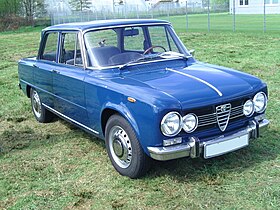Alfa Romeo TI Super
| Alfa Romeo Giulia (Type 105) | |
|---|---|

Alfa Romeo Giulia Super
|
|
| Overview | |
| Manufacturer | Alfa Romeo |
| Production | 1962–1978 |
| Assembly |
Portello, Milan, Italy (1962–1965) Arese, Milan, Italy (1965–1978) Setúbal, Portugal (Movauto) |
| Designer | Giuseppe Scarnati |
| Body and chassis | |
| Class | Large family car (D) |
| Body style | 4-door notchback saloon 4-door estate |
| Layout | Front-engine, rear-wheel-drive |
| Related | |
| Powertrain | |
| Engine | |
| Transmission | 4-speed manual (Giulia 1300) 5-speed manual |
| Dimensions | |
| Wheelbase | 2,510 mm (98.8 in) |
| Length | 4,140 mm (163.0 in) |
| Width | 1,560 mm (61.4 in) |
| Height | 1,430 mm (56.3 in) |
| Kerb weight | 978–1,130 kg (2,156–2,491 lb) |
| Chronology | |
| Predecessor | Alfa Romeo Giulietta (750/101) |
| Successor | Alfa Romeo Giulietta (116) |
Alfa Romeo Giulia is the name of three not directly related models by the Italian car manufacturer Alfa Romeo. The first is a line of sporty four-door compact executive cars (Type 105) produced from 1962 to 1978, the second is an updated, mainly up-engined Spider, Sprint and Sprint Speciale Giuliettas, and the third Giulia is a compact executive car (type 952) unveiled in 2015.
Alfa Romeo was one of the first mainstream manufacturers to put a powerful engine in a light-weight 1,000 kilograms (2,205 lb) four-door car for mass production. The Type 105 Giulia was equipped with a light alloy twin overhead camshaft four-cylinder engine similar to that of the earlier Giulietta (750/101) range, available in 1.3-litre (1,290 cc) and 1.6-litre (1,570 cc) versions. Various configurations of carburetors and tuning produced power outputs from about 80 to about 110 bhp (55 to 75 kW), coupled in most cases to 5-speed manual transmission.
Giulia sedans were noted for lively handling and impressive acceleration among small European four-door sedans of their era, especially considering modest engine sizes offered. The popular Super version with the twin carburettor 1.6 litre engine had a top speed of 170 km/h (106 mph) and accelerated from 0 to 100 km/h (62 mph) in about 12 seconds, better than many sports cars of the late 1960s and early 1970s. When leaving the factory all variations of the Giulia originally fitted either Pirelli Cinturato 165HR14 tyres (CA67) or Pirelli Cinturato 155HR15 tyres (CA67).
The styling of the boxy four-door notchback saloon was somewhat wanting. The engine bay, cabin and boot were all square shaped, buffered somewhat by details on the grill, roofline, bonnet and boot. Use of a wind tunnel during development led to a very aerodynamic shape that produced a drag coefficient of Cd=0.34, particularly low for a saloon of the era.
...
Wikipedia
